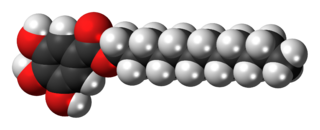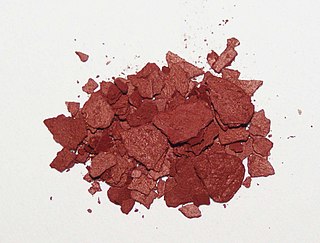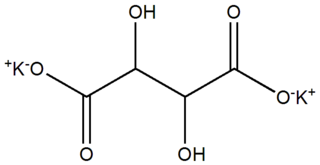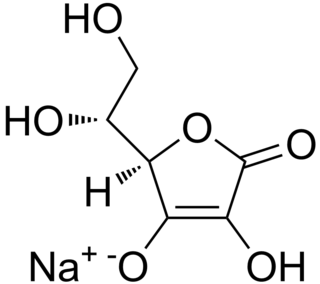 W
WAnoxomer is a food additive with E number E323. It is a non-digestible polymeric antioxidant. It was designed to allow the introduction of established antioxidants in a non-absorbable manner in order to avoid potential health risk associated with their digestion.
 W
WAscorbyl palmitate is an ester formed from ascorbic acid and palmitic acid creating a fat-soluble form of vitamin C. In addition to its use as a source of vitamin C, it is also used as an antioxidant food additive. It is approved for use as a food additive in the EU, the U.S., Canada, Australia, and New Zealand.
 W
WBetalains are a class of red and yellow tyrosine-derived pigments found in plants of the Caryophyllales, where they replace anthocyanin pigments. Betalains also occur in some higher order fungi. They are most often noticeable in the petals of flowers, but may color the fruits, leaves, stems, and roots of plants that contain them. They include pigments such as those found in beets.
 W
WButylated hydroxyanisole (BHA) is an antioxidant consisting of a mixture of two isomeric organic compounds, 2-tert-butyl-4-hydroxyanisole and 3-tert-butyl-4-hydroxyanisole. It is prepared from 4-methoxyphenol and isobutylene. It is a waxy solid used as a food additive with the E number E320. The primary use for BHA is as an antioxidant and preservative in food, food packaging, animal feed, cosmetics, rubber, and petroleum products. BHA also is commonly used in medicines, such as cholecalciferol, isotretinoin, lovastatin, and simvastatin, among others.
 W
WButylated hydroxytoluene (BHT), also known as dibutylhydroxytoluene, is a lipophilic organic compound, chemically a derivative of phenol, that is useful for its antioxidant properties. BHT is widely used to prevent free radical-mediated oxidation in fluids and other materials, and the regulations overseen by the U.S. F.D.A.—which considers BHT to be "generally recognized as safe"—allow small amounts to be added to foods. Despite this, and the earlier determination by the National Cancer Institute that BHT was noncarcinogenic in an animal model, societal concerns over its broad use have been expressed. BHT has also been postulated as an antiviral drug, but as of March 2020, use of BHT as a drug is not supported by the scientific literature and it has not been approved by any drug regulatory agency for use as an antiviral.
 W
Wtert-Butylhydroquinone is a synthetic aromatic organic compound which is a type of phenol. It is a derivative of hydroquinone, substituted with a tert-butyl group.
 W
WCalcium erythorbate is a food additive. Chemically, it is the calcium salt of erythorbic acid, with the chemical formula Ca(C6H7O6)2. As an antioxidant structurally related to vitamin C, it helps improve flavor stability and prevents the formation of carcinogenic nitrosamines.
 W
WCalcium lactate is a white crystalline salt with formula C6H10CaO6, consisting of two lactate anions H3C(CHOH)CO−2 for each calcium cation Ca2+. It forms several hydrates, the most common being the pentahydrate C6H10CaO6·5H2O.
 W
WDodecyl gallate, or lauryl gallate, is the ester of dodecanol and gallic acid. As a food additive it is used under the E number E312 as an antioxidant and preservative.
 W
WErythorbic acid is a stereoisomer of ascorbic acid. It is synthesized by a reaction between methyl 2-keto-D-gluconate and sodium methoxide. It can also be synthesized from sucrose or by strains of Penicillium that have been selected for this feature. It is denoted by E number E315, and is widely used as an antioxidant in processed foods.
 W
WEthoxyquin (EMQ) is a quinoline-based antioxidant used as a food preservative in certain countries and originally to control scald on pears after harvest. It is used as a preservative in some pet foods to slow the development of rancidity of fats. Ethoxyquin is also used in some spices to prevent color loss due to oxidation of the natural carotenoid pigments.
 W
WEthyl gallate is a food additive with E number E313. It is the ethyl ester of gallic acid. Ethyl gallate is added to food as an antioxidant.
 W
WHexylresorcinol is an organic compound with local anaesthetic, antiseptic, and anthelmintic properties.
 W
WIndicaxanthin is a type of betaxanthin, a plant pigment present in beets, in Mirabilis jalapa flowers, in cacti such as prickly pears or the red dragonfruit. It is a powerful antioxidant.
 W
WLutein is a xanthophyll and one of 600 known naturally occurring carotenoids. Lutein is synthesized only by plants, and like other xanthophylls is found in high quantities in green leafy vegetables such as spinach, kale and yellow carrots. In green plants, xanthophylls act to modulate light energy and serve as non-photochemical quenching agents to deal with triplet chlorophyll, which is overproduced at very high light levels, during photosynthesis. See xanthophyll cycle for this topic.
 W
WLycopene is a bright red carotenoid hydrocarbon found in tomatoes and other red fruits and vegetables, such as red carrots, watermelons, grapefruits, and papayas. It is not present in strawberries or cherries. Although lycopene is chemically a carotene, it has no vitamin A activity.
 W
WMineral ascorbates are a group of salts of ascorbic acid. They are composed of a mineral cation bonded to ascorbate.
 W
WOctyl gallate is the ester of 1-octanol and gallic acid. As a food additive, it is used under the E number E311 as an antioxidant and preservative.
 W
WPotassium erythorbate (C6H7KO6) is a food additive. Chemically, it is the potassium salt of erythorbic acid. As an antioxidant structurally related to vitamin C, it helps improve flavor stability and prevents the formation of carcinogenic nitrosamines.
 W
WPotassium sodium tartrate tetrahydrate, also known as Rochelle salt, is a double salt of tartaric acid first prepared by an apothecary, Pierre Seignette, of La Rochelle, France. Potassium sodium tartrate and monopotassium phosphate were the first materials discovered to exhibit piezoelectricity. This property led to its extensive use in "crystal" gramophone (phono) pick-ups, microphones and earpieces during the post-World War II consumer electronics boom of the mid-20th century. Such transducers had an exceptionally high output with typical pick-up cartridge outputs as much as 2 volts or more. Rochelle salt is deliquescent so any transducers based on the material deteriorated if stored in damp conditions.
 W
WPotassium tartrate, dipotassium tartrate or argol has formula K2C4H4O6. It is the potassium salt of tartaric acid. It is often confused with potassium bitartrate, also known as cream of tartar. As a food additive, it shares the E number E336 with potassium bitartrate.
 W
WPropyl gallate, or propyl 3,4,5-trihydroxybenzoate is an ester formed by the condensation of gallic acid and propanol. Since 1948, this antioxidant has been added to foods containing oils and fats to prevent oxidation. As a food additive, it is used under the E number E310.
 W
WRacemic acid is an old name for an optically inactive or racemic form of tartaric acid. It is an equal mixture of two mirror-image isomers (enantiomers), optically active in opposing directions. It occurs naturally in grape juice.
 W
WSodium erythorbate (C6H7NaO6) is a food additive used predominantly in meats, poultry, and soft drinks. Chemically, it is the sodium salt of erythorbic acid. When used in processed meat such as hot dogs and beef sticks, it increases the rate at which nitrite reduces to nitric oxide, thus facilitating a faster cure and retaining the pink coloring. As an antioxidant structurally related to vitamin C, it helps improve flavor stability and prevents the formation of carcinogenic nitrosamines. When used as a food additive, its E number is E316. The use of erythorbic acid and sodium erythorbate as a food preservative has increased greatly since the U.S. Food and Drug Administration banned the use of sulfites as preservatives in foods intended to be eaten fresh (such as ingredients for fresh salads) and as food processors have responded to the fact that some people are allergic to sulfites. It can also be found in bologna, and is occasionally used in beverages, baked goods, and potato salad.
 W
WTartaric acid is a white, crystalline organic acid that occurs naturally in many fruits, most notably in grapes, but also in bananas, tamarinds, and citrus. Its salt, potassium bitartrate, commonly known as cream of tartar, develops naturally in the process of fermentation. It is commonly mixed with sodium bicarbonate and is sold as baking powder used as a leavening agent in food preparation. The acid itself is added to foods as an antioxidant E334 and to impart its distinctive sour taste.
 W
WVitamin C is a vitamin found in various foods and sold as a dietary supplement. It is used to prevent and treat scurvy. Vitamin C is an essential nutrient involved in the repair of tissue and the enzymatic production of certain neurotransmitters. It is required for the functioning of several enzymes and is important for immune system function. It also functions as an antioxidant. Most animals are able to synthesize their own vitamin C, although humans, the other great and lesser apes, monkeys, most bats, some rodents, and certain other animals must acquire it from dietary sources.
 W
WVitamin E is a group of eight fat soluble compounds that include four tocopherols and four tocotrienols. Vitamin E deficiency, which is rare and usually due to an underlying problem with digesting dietary fat rather than from a diet low in vitamin E, can cause nerve problems. Vitamin E is a fat-soluble antioxidant which may help protect cell membranes from reactive oxygen species.